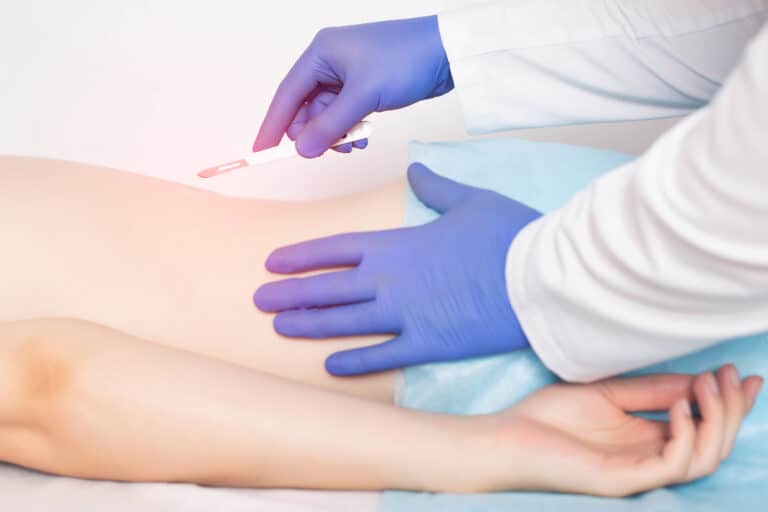Both headaches and migraines cause mild to severe pain and discomfort, and questions may surface among headache and migraine sufferers regarding the differences between the two.
This blog will examine the following questions:
- How do I know if my headache is a migraine?
- When should I be worried about a headache?
- What are the symptoms of migraines vs. headaches?
- What are the different types of headaches?
- What are the treatments for migraines vs. headaches?
How Do I Know if My Headache is a Migraine?
By definition, a headache is a pain that occurs in any area of the head, lasting anywhere from a few minutes to a few days. Headaches are also generally characterized by the pain they cause, often described as sharp, throbbing, or dull.
Migraines are similar to headaches concerning the type of pain they produce (i.e., throbbing, pulsating, etc.). Still, migraine pain is typically more intense on one side of the head. In some instances, however, migraines will develop on both sides of the head.
Migraines generally differ from typical headaches due to visual and auditory disturbances that may accompany pain, nausea, or vomiting. Migraines may also last from 4 to 72 hours long.
When Should I Be Worried About a Headache?

Contact your doctor if your headache occurs more frequently, is associated with severe pain, or interferes with daily living. Underlying conditions can cause head pain, and it’s important to rule these out. Likewise, the sooner you reach out for support, the sooner you can find the right treatment to manage headache symptoms.
Symptoms of Migraines vs. Headaches
Symptoms vary from person to person. According to studies done on individuals with migraines and headaches:
- 85% of migraine sufferers experience throbbing, pulsing pain
- 80% to 90% experience sensitivity to light
- 70% to 80% experience sensitivity to sound
- 8 out of 10 sufferers feel nauseous
Before or during a migraine attack, a person may experience visual auras. Auras are neurological symptoms that generate visual disturbances in the form of blind spots, colored spots, flashing lights, tunnel or blurred vision, zigzag lines, or temporary blindness. Other aura symptoms may include numbness, tingling, weakness, dizziness, or feelings of spinning.
Headaches, conversely, are not accompanied by an aura but can range from mild to severe in intensity. Common headaches that may cause symptoms similar to migraines include cluster headaches, sinus headaches, and tension headaches.
What are the Different Types of Headaches?
Cluster Headaches
Cluster headaches are appropriately named after the intense pain they cause in clusters or cyclical patterns. Pain may be described as burning, piercing, or constant, and like most headaches, the pain usually affects one side of the head, most commonly in a cluster behind one eye. This type of headache is considered one of the most painful and may be triggered by certain foods, hormonal changes, or stress.
Avoid alcohol, nicotine, and nitroglycerin, a medication used to treat heart disease, as these may be possible triggers.
Additionally, you must maintain a regular sleep schedule. Researchers have found cluster headaches tend to develop with changes in sleep schedules.
Sinus Headaches
Sinus headaches produce relatively moderate pains centrally located on the face, i.e., parts of the forehead, the bridge of the nose, and areas around the cheeks. As a result, symptoms may include facial swelling, fever, a runny nose, or ear pain. Patients may also experience a feeling of fullness in the ears.
These headaches are usually associated with other sinus issues, including allergies and sinus infections. Your risk of developing sinus headaches increases if you have a family history of migraines and headaches or if you’re experiencing hormonal changes. Certain foods (caffeine, alcohol), odors, and inactivity may trigger a sinus headache.
Tension Headaches
Tension headaches may generate symptoms that closely resemble migraines but are usually different in intensity, type, and location. Symptoms of a tension headache include dull, aching head pain, pressure across the forehead and along the sides and back of your head, tenderness of the scalp, neck or shoulder pain, and chronic fatigue.
Tension headaches are typically caused by stress, upper body tension, or muscle tenderness. Like cluster and sinus headaches, tension headaches may also be triggered by certain foods, odors, fatigue, or alcohol and caffeine consumption.
Treatments for Migraines vs. Headaches
Treatment may vary depending on the headache type or migraine. A combination of medications or therapies may be considered for those suffering from symptoms such as nausea, vomiting, muscle pain, or irritability. Patients must see their doctor immediately if symptoms have been present for over a few weeks.
Treatment options may include pain-relieving medications, preventative medications, or interventional pain management therapies such as occipital nerve blocks, Botox, or an innovative, minimally invasive surgical procedure called the Omega migraine procedure.
Omega Migraine Procedure
The Omega migraine procedure is a surgical procedure based on neurostimulation that provides long-lasting pain relief for chronic migraines. Patients who have not responded to conservative or interventional treatment options for at least six months may be considered candidates for the procedure. A board-certified, interventional pain management specialist will perform an evaluation before moving forward with a trial procedure.
During the trial period, a neurostimulator will be placed externally for several days to determine whether or not the patient will benefit from having a permanent device implanted. Patients will be encouraged to trigger their migraines as much as possible to see if the implant works.
Once the trial has been determined as successful and the patient is ready to receive their permanent device, physicians will implant small, undetectable wires under the skin surrounding the forehead. Once these wires are in place, they will be connected to a small, rechargeable battery implanted under the skin in the lower back or upper buttock region.
The battery is designed to last up to ten years and will deliver gentle electrical pulses to prevent pain signals from reaching the brain. Talk to your pain management physician about how you may benefit from the Omega migraine procedure.
Published On: July 31, 2015
Updated On: April 18, 2023



